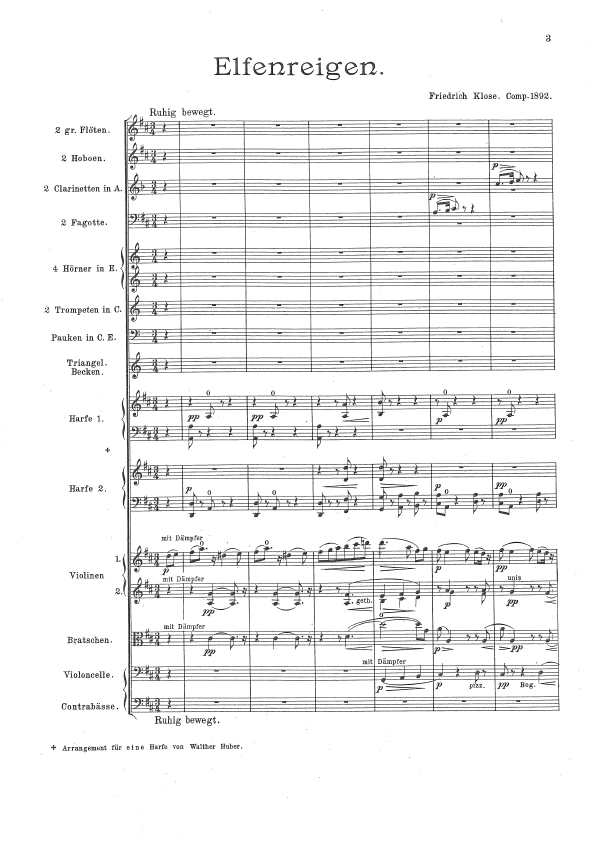
Friedrich Klose
(b. Karlsruhe, 29. November 1862 – d. Ruvigliana, 24. December 1942)
Elfenreigen
Preface
Elfenreigen was the first published orchestral work from the pen of Friedrich Klose, a well-known composer and teacher around the turn of the twentieth century. In Karlsruhe, where he was born, he came under the influence of Felix Mottl, who had assisted Richter in preparing Wagner’s Ring in Bayreuth. At the age of nineteen he attended the premiere of Parsifal there in 1882. He studied at the University of Geneva and then went to Vienna to work with Bruckner. He later wrote a memoir of his time as Bruckner’s student. He then returned to Geneva as a teacher at the Music Academy. He later taught in Basel and Munich and in later years devoted his time to writing rather than composition, living in Switzerland until his death in 1942.
He wrote songs, choral music, chamber music and a few orchestral works, of which Elfenreigen (Dance of the Elves) is the best known. It was conceived as an illustration of the opening scene of Part II of Goethe’s Faust, where Faust is lying on a flowery bed, restless and trying to sleep. The spirit Ariel, accompanied by Aeolian harps, invokes the elves to dance around him and raise his spirits so that he can sleep, free of care and anxiety.
Hovering around his head in breezy circles
Reveal yourselves as the elves you are;
Calm the sore disturbance of his heart
And free him from the barbs of bitterness.
The dance is conceived as a ternary scherzo with trio, returning to the main section. Ariel’s harps are fully represented in the orchestration, accompanying the opening melody in the violins. After a dramatic intrusion from the harps (p. 10), the main them returns, more fully scored (p. 12). For the central section (p. 16) Klose moves to the key of A and a lilting 9/8 rhythm, to suggest the elves lulling Faust to sleep. But the music gathers strength to a climax (p. 19) and repeats the lullaby in richer scoring.
What follows is more dramatic (p.22), but this is only the link back to the original dance melody which is now more active and rich than before, with the trumpet finally taking the tune (p. 34). The coda is introduced by a solo violin, and two bassoons are almost the last of the elves to be heard. One big chord and a few flutters from violins and triangle, and the dance is over.
Klose’s style might be usefully compared to that of his contemporary Hugo Wolf, another student of Bruckner, especially in the deft handling of modulation and chromatic movement. Bruckner himself is suggested by Klose’s melodic style in the central lullaby section of the work.
Elfenreigen was first performed in Geneva early in 1891, when the composer was twenty-nine. It was conducted by Leonetto Banti, to whom the score was dedicated.
Hugh Macdonald, 2013
Friedrich Klose
(geb. Karlsruhe, 29. November 1862 – gest. Ruvigliana, 24. Dezember 1942)
Elfenreigen
Vorwort
Elfenreigen war das erste veröffentlichte Orchesterwerk aus der Feder von Friedrich Klose, einem bekannten Komponisten und Lehrer um die Wende zum 20. Jahrhundert. In Karlsruhe, seiner Geburtsstadt, kam er unter den Einfluss von Felix Mottl, der Richter bei den Vorbereitungen zu Wagners Ring assistiert hatte. Im Alter von 19 Jahren erlebte er dort die Premiere von Parsifal. Klose studierte in Genf und ging darauf nach Wien, um mit Bruckner zu arbeiten. Später schrieb er Erinnerungen an seine Zeit als Bruckners Student. Er kehrte nach Genf als Lehrer an der Musikakademie zurück, um anschliessend in Basel und München zu lehren. In seinen späten Jahren widmete er sich in seinem Schweizer Domizil bis zu seinem Tod ausschliesslich dem Komponieren.
Klose schrieb Lieder, Chormusik und einige Werke für Orchester, von denen Elfenreigen das bekannteste ist. Konzipiert war das Werk als Illustration der Eröffnungsszene von Goethe‘s Faust II, in der Faust auf einem Bett aus Blüten liegt, ruhelos und nach Schlaf suchend. Der Geist Ariel, begleitet von äolischen Harfen, beschwört die Elfen, um ihn herumzutanzen, damit sich seine Stimmung hebe und er ohne Furcht und Sorge schlafen könne.
Die ihr dies Haupt umschwebt im luft‘gen Kreise,
Erzeigt euch hier nach edler Elfen Weise,
Besänftiget des Herzens grimmen Strauß,
Entfernt des Vorwurfs glühend bittre Pfeile,
Sein Innres reinigt von erlebtem Graus.
Der Tanz ist als ternäres Scherzo mit Trio gestaltet und wendet sich schliesslich in die Hauptsektion zurück. Ariels Harfen werden in der Orchestration vollständig wiedergegeben und begleiten die eröffnende Melodie der Geigen. Nach einem dramatischen Eindringen der Harfen (S.10) kehrt das Hauptthema zurück, dichter orchestriert (S.12). Für den Hauptteil (S.16) bewegt Klose die Tonart mit einem trällernden 9/8 - Rhythmus nach A, ein Abbild der Elfen, die Faust in den Schlaf singen. Die Musik sammelt wieder Kräfte bis zu einem Höhepunkt (s.19) und gibt das Schlaflied in reicherer Orchestrierung ein weiteres Mal wieder.
Was nun folgt, klingt dramatischer (S.22), ist tatsächlich aber nur die Verbindung zurück zur originalen Tanzmelodie, die nun aktiver und reicher ist als zuvor, mit einer Trompete, die schliesslich die Melodie übernimmt (S.34). Die Koda wird von der Sologeige eingeführt, und was als Letztes von den Elfen zu vernehmen ist, sind zwei Fagotte. Ein starker Akkord und etwas Flattern von Geigen und Triangel, schon ist der Tanz vorbei.
Es ist hilfreich, Kloses Stil mit dem seines Zeitgenossen Hugo Wolf zu vergleichen, eines weiteren Studenten von Bruckner, insbesondere was die geschickte Handhabung von Modulation und chromatischer Bewegung betrifft. Bruckner selbst findet man in der Melodik des Hauptteils, dem Schlaflied, wieder.
Elfenreigen erlebte seine Uraufführung früh im Jahr 1891 in Genf, als der Komponist 29 Jahre alt war. Die Aufführung wurde von Leonetto Banti dirigiert, dem auch das Werk gewidmet war.
Hugh Macdonald, 2013
Aufführungsmaterial ist von Leuckart, München, zu beziehen. Nachdruck eines Exemplars der Musikbibliothek der Münchner Stadtbibliothek, München.